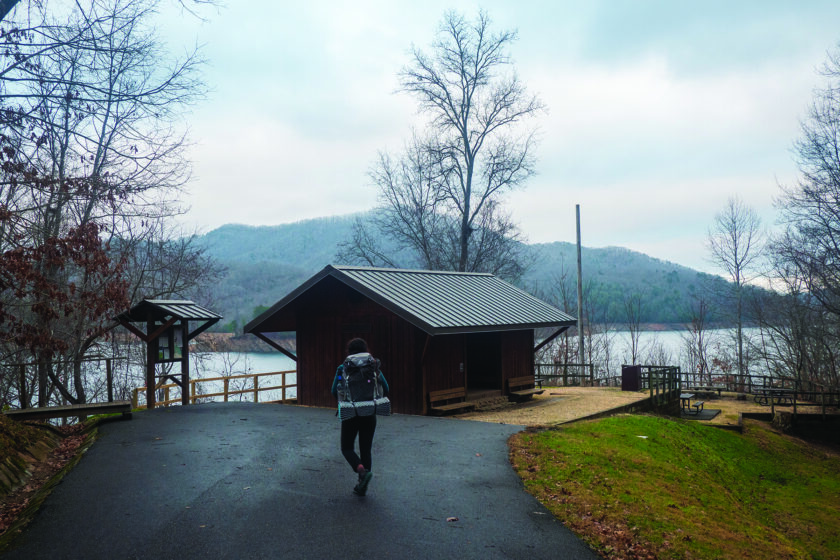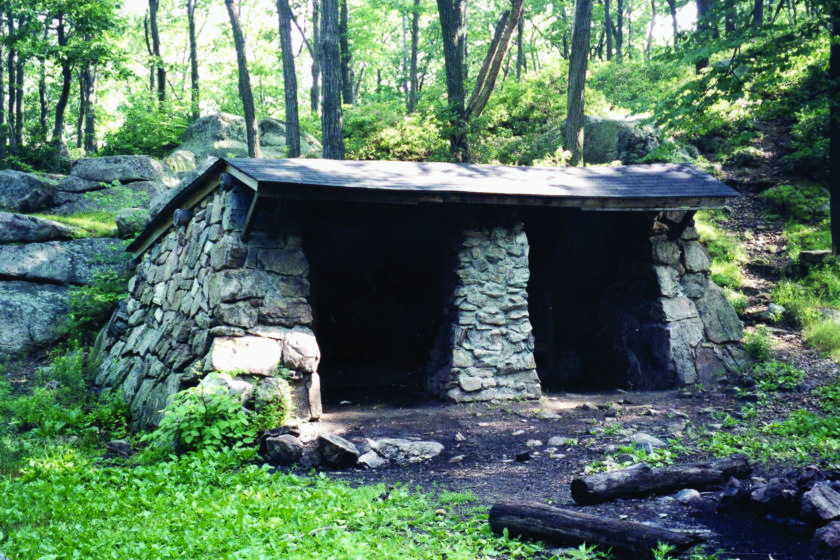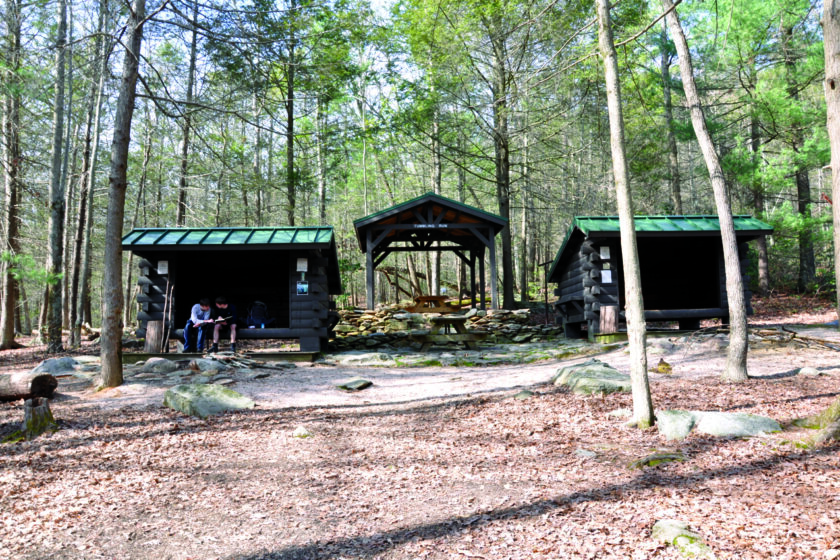By Tracy López
Improving Nights in the Woods
January 30, 2025
Protected beneath the dense canopy of the forest, another world emerges as the sun sets and the last golden rays of sunlight find their way through. Birds settle in with folded wings on oak, maple, and hickory tree branches, and fireflies emerge to take their shift as they blink love letters to one another. Hoots of barred owls, the lullaby of crickets, or the calls of tree frogs fill the darkness. Night on the Appalachian Trail can be a magical experience. And a weary hiker settling into a tent, hammock, or shelter can experience this magic and get much-needed rest at one of the A.T.’s nearly 400 recognized overnight sites.
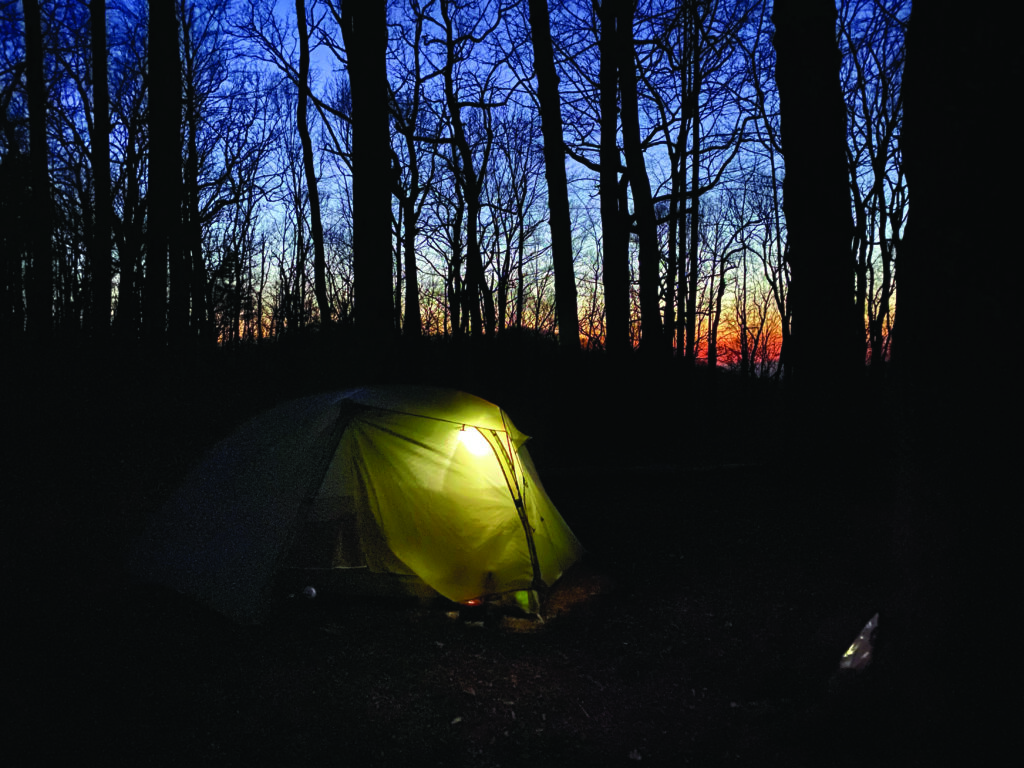
“After a day’s hike, it is good to know that your destination will provide a suitable place to spend the night, usually with the basic amenities of nearby water — which should be more than 200 feet away — and a smooth, drained spot for a tent or a simple shelter.” ~Morgan Sommerville. Photo by Elizabeth Saetta.
In his vision for a long-distance trail through the Appalachian Mountains, Benton MacKaye listed “shelter camps” as one of four key features, describing them as follows: “They should be located at convenient distances so as to allow a comfortable day’s walk between each. They should be equipped always for sleeping and certain of them for serving meals….” The first such structures to be built along the A.T. were in New England and were inspired by the European huts that have provided accommodations for mountaineers for centuries.
“There have been overnight sites along the A.T. pretty much since the beginning,” explains Morgan Sommerville, director of Visitor Use Management (VUM) of the Appalachian Trail Conservancy. “Adirondack-style shelters were built because lightweight tents were not commonly available. Originally, many had pole floors and users were expected to go into the surrounding forest to cut tree boughs to stack on the poles for bedding.”
Today, of course, such destruction of nature is no longer an acceptable practice. As gear has gotten lighter — and more water-resistant — sleeping in tents or hammocks instead of shelters has become widespread. As a result, recognized overnight sites on the Trail now include more than 100 campsites in addition to some 280 shelters. There are also an estimated 5,000 unofficial, visitor-created overnight sites.The increase in Trail visitation in recent years has had a huge impact on overnight sites and the surrounding natural environment. When hikers arrive on a rainy evening at a shelter filled to capacity, in a rush to set up a tent before heavier rain sets in, they will often expand existing nearby campsites or create new ones. After a long day spent with only their own thoughts for company, hikers may be drawn to the conviviality of a campsite dotted with a dozen or so tents and decide to join the fun, despite contributing to the sprawl. Hikers who prefer solitude may arrive at a crowded area and venture off the Trail to find or create a new campsite for a quiet night’s rest.
As these extended sites or new camping areas — and the humanmade paths to them — are constantly reused, some have become unacceptably large “mega-campsites” or “mega-clusters” of high-density campsites. Soil is compacted, surrounding vegetation is destroyed, and erosion in the area worsens. The sediment and other runoff that is no longer filtered by plants or organic litter ends up in nearby water bodies. Rare species found around these areas are negatively impacted.
“It’s an ecological and social nightmare,” says Jeff Marion, a recreation ecologist with the U.S. Geological Survey, stationed at Virginia Tech University in Blacksburg, Virginia. “The areas of intense camping impact expand over time due to campsite expansion and proliferation in flat, popular areas near water. This often happens in high densities that degrade the social or experiential conditions the A.T. community seeks to provide.” Without professional management there is little to no opportunity for these areas to recover, and parts of the Trail and its surrounding protected corridor can suffer lasting damage.
Making Overnight Sites Sustainable
Enter the ATC’ s Sustainable Overnight Sites program — or SOS for short. The program’s goals are to evaluate all overnight sites along the A.T. and then rehab, remove, or replace any that do not meet sustainability criteria. These criteria are intended to actively shift camping to a subset of sustainable campsites. These are located in areas that resist expansion and proliferation while enhancing social conditions. A core objective is to minimize the total area of camping impact, which reduces vegetation loss, soil compaction and erosion, and high-density camping. This provides greater protection of both resources and social conditions. ATC staff, land managers, volunteers, and scientists have been developing and applying the criteria since the 1990s. However, according to Sommerville, the standards came into practice near the end of finishing the A.T. shelter chain, so sites that have not benefited from them outnumber the sustainable overnight sites.

The Hawk Mountain Shelter Area in Georgia (shown here in 2009) is an example of how heavy use and visitor-created expansion causes serious environmental damage to the sites and, by extension, to the Trail corridor. The campsite has since been moved and the surrounding area is recovering. Photo by G N Bassett (CC BY-ND 2.0).
The program is largely informed by years of research Marion and his teams conducted on the A.T. and in other protected areas. “One noteworthy recent finding was that sites located in sloped terrain — more than 15 percent grade — naturally constrain both site expansion and proliferation pressures,” explains Marion. “Even better is that this results from campers interacting with the surrounding natural topography rather than from staff-intensive educational messaging, regulations, or law enforcement.”
According to Sommerville, “The ideal sites are located and built in concert with our recently completed A.T. Experience Analysis so that they preserve the most natural experience possible. When properly located, they provide more privacy than traditional overnight sites.” Marion also points out that the smaller sustainable sites are easier for managers and stewards to monitor and maintain, which is necessary for preserving natural conditions and the Trail experience.
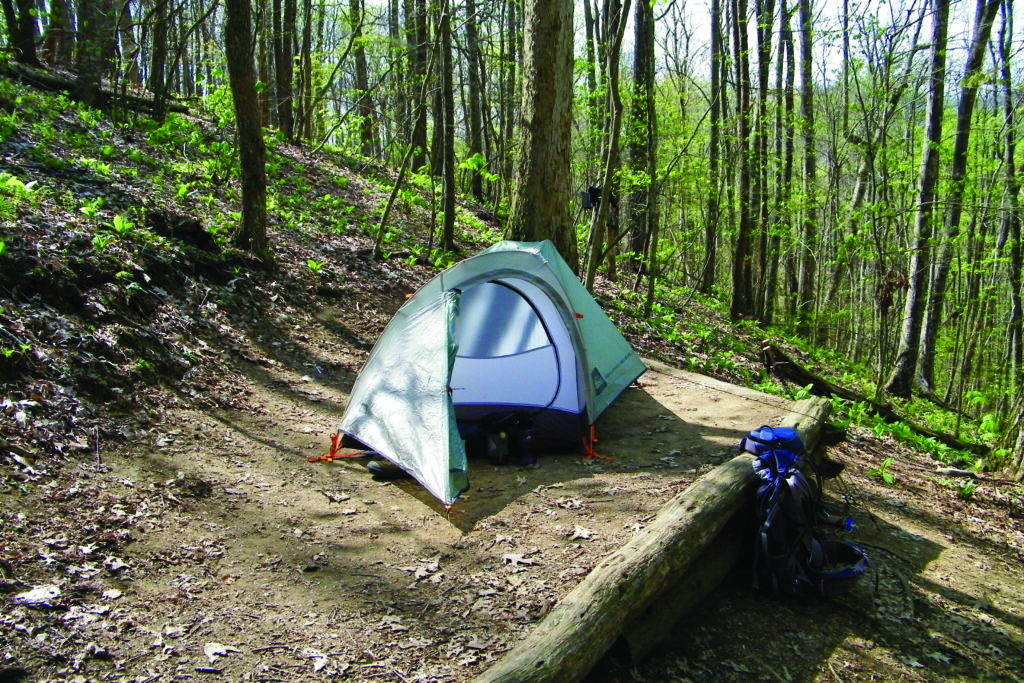
Earthen tent pads dug into hillsides — such as Backcountry Campsite 113 (also known as the Birch Spring Gap Campsite) in Great Smoky Mountains National Park — provide hikers with designated sites to pitch their tents. Not only are they natural in appearance, but they also help to prevent site expansion. Photo by Brian Greer (Trail name: “Bandit”).
“Previous definitions of the A.T. experience were applied at a Trail-wide level with no good means for applying them at a local level,” says Sommerville. The ATC has since developed management prescriptions and criteria for an experience spectrum from primitive to urban that produces a local gap analysis between the current and desired A.T. experience. Managers and maintainers can then make appropriate decisions about the extent and type of facilities to provide. The SOS program will ensure that both local and Trail-wide needs are being met for sustainability and improved visitor experiences.
A Ticking Clock
Implementation of the SOS program needs to advance before the overnight site conditions further deteriorate, which poses increased rehabilitation and environmental costs. “Climate change is also having an impact on the Trail and its sites,” explains Marion. “The increased frequency and intensity of weather events further degrades both campsite and Trail.” For example, large campsites or clusters of sites have much larger numbers of damaged and dying trees that large storm events can bring down, endangering both campers and aging shelters.
Undertaking a project of this size and complexity requires dedicated funding far greater than what is typically needed for routine, annual upkeep and repairs. Little to no government funding is allocated for planning, design, or maintenance of overnight sites or shelters, so funds from private donors are essential.
“Donor funding is allowing us to begin the inventory and priority-setting in close cooperation with local A.T. managers in the Clubs and agencies, which sets the stage for a continuous flow of overnight site mitigation projects,” says Sommerville. The ATC also plans to investigate design and construction of group-specific overnight sites, which donor funding can help optimize. Funds would also support data acquisition that will help A.T. managers prioritize areas for work and help the ATC learn about day hikers — a population for whom there is very little data — and the negative impacts associated with the large annual bubble of thru-hikers.

Mountaineer Falls Shelter in Tennessee is an example of a sustainably built shelter along the A.T. Following Jeff Marion’s sidehill guidelines, the shelter was built in 2006 on sloped terrain. Photo courtesy of Tim Stewart (Trail name: “mountain squid”).
Generous donors have helped start the program, but more funding is needed for this vital preservation project. “Our family foundation views the sustainable overnight campsites program as a great way to invest in the Appalachian Trail and its corridor over the next century,” says Greg Winchester, ATC donor and board member. “The program will improve the overall hiker experience from the day hiker to the thru-hiker. It will remove blighted and eroded campsites and replace them with new campsites that are both aesthetically appealing and ecologically friendly. As the most well-known long-distance trail in the world, the A.T. deserves this program of excellence.”
A Trail Experience for Everyone
Everyone who camps on the Trail has their own unique preferences. Marion, a founding member of the ATC Stewardship Council, spent forty-three years section hiking the A.T. He practices Dispersed Pristine Site Camping in areas of the Trail where it is allowed. When done properly, he explains, this practice results in no lasting resource impact and a low probability of anyone reusing the same camping spot. The primary challenges are the A.T. community’s ability to fully convey these low-impact practices and visitors fully learning and applying them to avoid creating new campsites. In some areas, it can be difficult or inappropriate to use this camping option. This is one of the many reasons why Marion feels it’s important to have sustainable well-established or designated campsites that any camper can use. He also recommends that hikers take advantage of reliable phone apps that can be increasingly used to identify the most preferred sustainable campsites and shelters, further limiting damage to the Trail and surrounding areas and preserving A.T. resource conditions for future visitors.
Fiona “Happy Feet” Russo of New Rochelle, New York, found that a hiking app helped her “get the scoop” on shelters and camping areas she considered staying in and alerted her to issues like mice or other potential problems. “I love camping by myself, I love camping at a shelter, tents, lean-tos — it’s all good with me,” she shares. An experienced backpacker and section hiker, Russo appreciates all the different benefits the Trail’s overnight sites provide, such as designated places to set up camp after a long hike and shelter from the elements. “A double-decker was essential to keeping me out of a heavy rainstorm after a long day on the Trail.”Beyond safety from the elements, the camaraderie and kindness she experienced from fellow hikers at the sites were some of the most striking moments of her time on the Trail. “At one shelter, a member of the tramily was experiencing snow for the very first time. She made a little snowman and put it on the ledge. Truly a memorable moment for all of us.”
To donate to or find out more about the progress of the Sustainable Overnight Sites Program and the ATC Stewardship Council’s Trail Management Committee, contact info@appalachiantrail.org
This article was originally published in the Summer 2024 edition of A.T. Journeys, the ATC’s member magazine. Become a member today to read more impactful and inspiring stories like this and help ensure the Appalachian Trail and its landscape are always protected, resilient and connected, so everyone can step on the path and walk away transformed.
Discover More
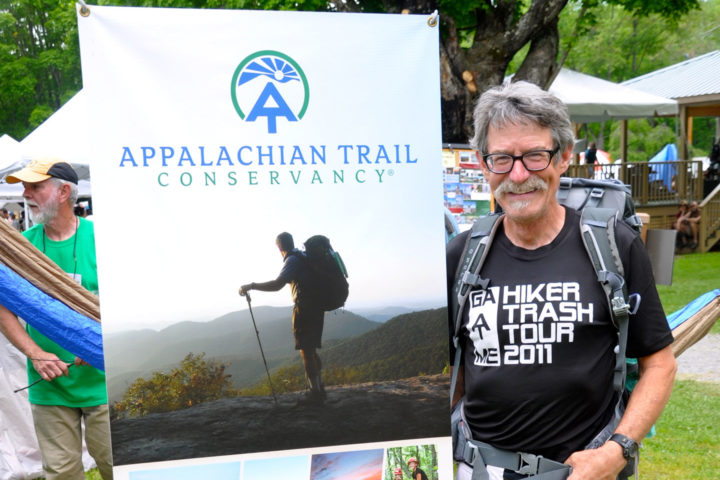
JOIN TODAY
Become a Member
Membership benefits include an oversized Appalachian Trail strip map, a subscription to our membership magazine A.T. Journeys, discounts at the Ultimate A.T. Store®, special volunteer opportunities and invitations to exclusive events.
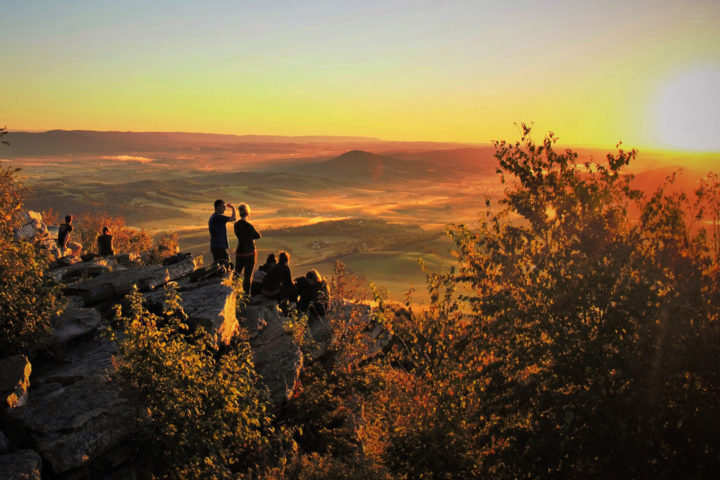
Official Blog
Protecting the A.T. Hiking Experience
Ever since the first foot of the Appalachian Trail was cleared, visitor use management has been essential for protecting A.T. resources and guiding hikers toward safe and Trail-friendly practices.
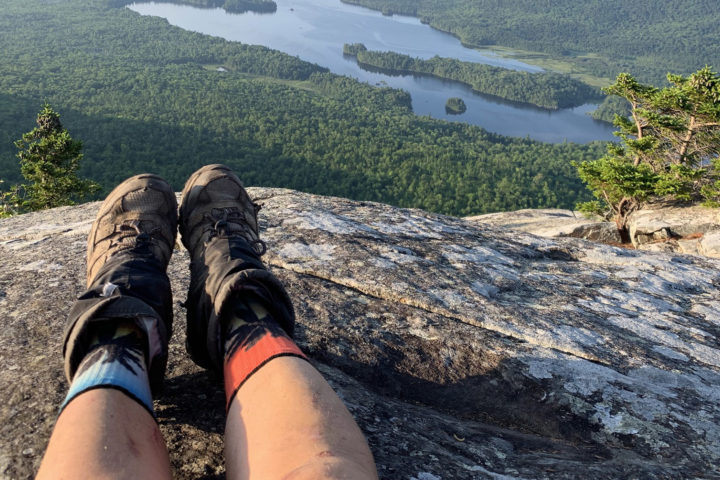
BACK TO THE BASICS
Leave No Trace
Wondering how you can take care of outdoor places like the Appalachian Trail (A.T.)?

